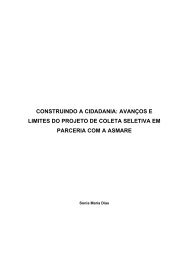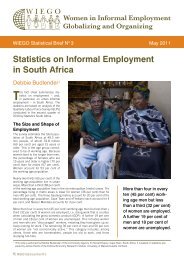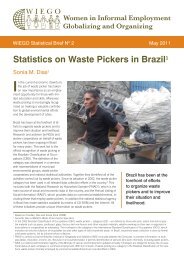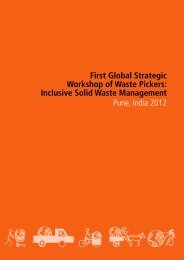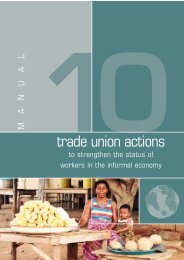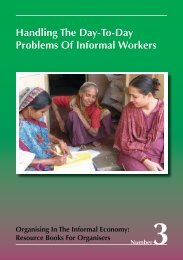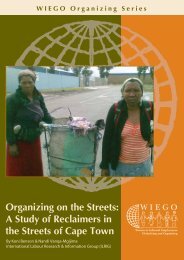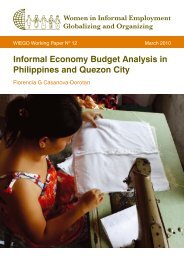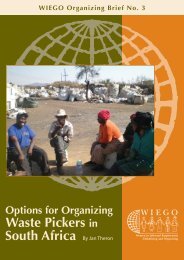Waste Pickers and Carbon Finance: Issues to Consider - WIEGO
Waste Pickers and Carbon Finance: Issues to Consider - WIEGO
Waste Pickers and Carbon Finance: Issues to Consider - WIEGO
- No tags were found...
Create successful ePaper yourself
Turn your PDF publications into a flip-book with our unique Google optimized e-Paper software.
<strong>WIEGO</strong> Technical Brief (Urban Policies) N o 7The CDM mechanism is intended <strong>to</strong> stimulate sustainable development <strong>and</strong> emission reductions, while givingindustrialized countries flexibility in how they meet their emission reduction targets.The process of having a project registered under the CDM, which is required for the project <strong>to</strong> sell carboncredits, is rigorous <strong>and</strong> requires specialized technical skills.A key aspect of the CDM is “additionality,” which means that a CDM project must provide emissionreductions that are additional <strong>to</strong> what would have occurred without the project. Projects must use theCDM’s “additionality <strong>to</strong>ol” (16 pages).Another key aspect of the CDM mechanism is the use of “methodologies,” including “baseline methodologies”<strong>and</strong> “moni<strong>to</strong>ring methodologies.” A baseline methodology is the means <strong>to</strong> estimate the emissions thatwould have been created in the absence of the project activity. A moni<strong>to</strong>ring methodology is the means <strong>to</strong>calculate the actual emission reductions from the project, setting out how projects should develop <strong>and</strong> implementa moni<strong>to</strong>ring plan <strong>to</strong> gather the data for calculating emission reductions from the project. The baselinemethodology <strong>and</strong> the moni<strong>to</strong>ring methodology must be specified in the Project Design Document (PDD).Currently approved small-scale methodologies are listed here.The most relevant existing methodology for MBOs involved in solid-waste management is probably “AMS-III.AJ. Recovery <strong>and</strong> recycling of materials from solid wastes.” The latest version of this methodology can beaccessed on the UNFCCC website (14 pages).A (1 page) summary of the methodology is also available.The greenhouse gas (GHG) benefit of recycling plastics is that less fossil-fuel energy is required <strong>to</strong>manufacture products from recycled materials than from virgin materials. Therefore, the carbon offse<strong>to</strong>r the number of carbon credits is the difference between the amount of GHG emissions from productsmanufactured with virgin materials <strong>and</strong> the amount of GHG emissions from products made of recycledmaterials.The methodology includes several important requirements. For example, contracts need <strong>to</strong> be put in place<strong>to</strong> eliminate double counting of emission reductions by both the waste pickers <strong>and</strong> the manufacturing facilitythey supply, <strong>and</strong> also <strong>to</strong> prove that the recycled materials supplied are used for processing/manufacturing<strong>and</strong> not for other purposes, such as fuel.One of the key documents required for the validation <strong>and</strong> registration of a CDM project activity is theProject Design Document (PDD). The other key documents are the validation report from the DesignatedOperational Entity (DOE) <strong>and</strong> the letter of approval from the Designated National Authority (DNA). A DOEis an independent audi<strong>to</strong>r that assesses whether a potential project meets all the eligibility requirementsof the CDM (validation) <strong>and</strong> whether the project has achieved GHG emission reductions (verification <strong>and</strong>certification). A DNA is the body granted responsibility by a national government <strong>to</strong> authorize <strong>and</strong> approveparticipation in CDM projects.In addition <strong>to</strong> demonstrating additionality <strong>and</strong> specifying the methodology <strong>to</strong> be used, the PDD must also:• describe the project <strong>and</strong> establish a project boundary• establish the duration <strong>and</strong> crediting period of the project• describe the environmental impacts of the project• provide information on the sources of public funding for the project• summarize stakeholder comments• describe the moni<strong>to</strong>ring plan• set out all relevant calculations14



